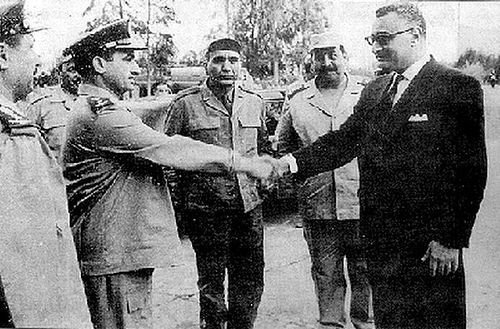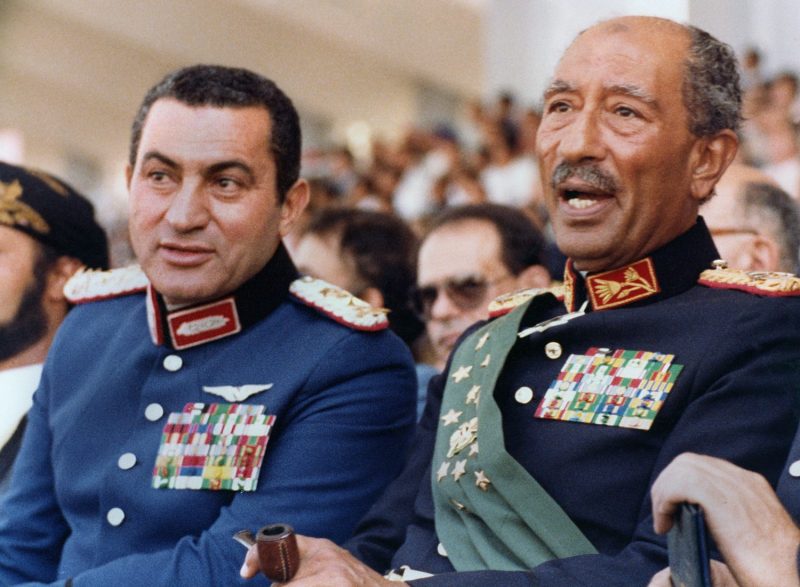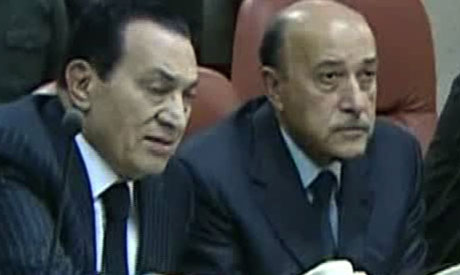Entry in the Oxford Companion to Comparative Politics (New York: Oxford University Press, c2013), Joel Krieger, editor in chief.
Born on 4 May 1928 in the Nile delta village of Kafr al-Mouseilha, Hosni Mubarak received his education in small schools in his home village. Upon finishing high school, he joined the Egyptian Military Academy, from which he graduated on 2 February 1949. He then joined the air force and received his commission as a pilot officer on 13 March 1950. Throughout his education, and unlike many of the young cadets of his generation, he did not develop any political interests or join any political organizations. For ten years and until early 1959, he worked as an aviation instructor in the Air Force Academy. After a few years of further military training in the Soviet Union, Mubarak returned to Egypt and took up command of a number of air bases. He was then chosen to head the Air Force Academy following Egypt’s catastrophic defeat in the June 1967 War; and after Gamal Abdel Nasser’s death in 1970, he was promoted to commander of the air force. Under his command, the Egyptian Air Force performed well during the early days of the October 1973 War against Israel; and following the war, Anwar Sadat promoted him to air chief marshal.

In 1975 Sadat named him vice president and entrusted him with important foreign policy missions, chief among which were mediating in the conflict over the Western (Spanish) Sahara and seeking the approval of Syria and Saudi Arabia in Egypt’s disengagement agreement with Israel.
On 6 October 1981 Mubarak was sitting next to Sadat in a military parade commemorating the anniversary of the 1973 war against Israel when a group of young officers aimed at the president, killing him instantaneously.

A few days later, Mubarak was sworn in as president of Egypt. Shaken by the assassination and informed that the assassins belonged to an Islamist cell within the army and were part of a larger plot to topple the regime, Mubarak imposed emergency laws and ordered his security forces to hound Islamist militants throughout the country. The confrontation with Muslim fundamentalists would prove to be a hallmark of Mubarak’s years in power. In 1995 he escaped an assassination attempt by Islamists during a trip to Ethiopia, thanks to precautions taken by his chief security officer, Omar Suleiman. The confrontation with Islamists reached a climax in 1997 when militants opened fire on foreign tourists in Luxor in an attempt to knock off the tourist industry and deprive the regime of much needed foreign currency. Mubarak responded by adopting an even more aggressive policy toward Islamists and by expanding his security agencies until they commanded 5 percent of gross domestic product by the late 1990s.

Aware of Egypt’s dire economic situation, Mubarak attempted to improve relations with the Arab world, especially the oil-rich states of Iraq, Libya, and Saudi Arabia, which were host to millions of Egyptian migrant workers. This required a tight balancing act as most Arab countries severed their links with Egypt after Sadat signed the peace treaty with Israel in 1979. Mubarak thus cooled off relations with Israel, especially following the Israeli invasion of Lebanon in 1982, while at the same time reasserting Egypt’s commitment to the peace treaty. In 1989 his efforts bore fruit when the Arab League readmitted Egypt as a full member and relocated its headquarters to Cairo.
Keen on maintaining military and economic support, Mubarak cultivated good relations with the United States. Following Iraq’s invasion of Kuwait in 1990, he supported the US-led military coalition against Iraq; and following the war, the United States, Europe, and the Arab Gulf countries rewarded Egypt by forgiving half of its foreign debt.
Reelected for a third term as president in 1993 and having bought some breathing space, Mubarak kept a close watch over Islamist opposition. His constant fear of this opposition, specifically of the Muslim Brotherhood, led Mubarak to resist increasing popular demands for the lifting of the emergency law, revising the constitution to allow for multicandidate presidential elections, holding free and fair parliamentary elections, and removing government control over the media.
Externally, Mubarak directed his energies to the Palestinian–Israeli conflict. He effectively removed this important portfolio from the Ministry of Foreign Affairs and handed it over to his trusted man, Omar Suleiman, who mediated between Israel and the Palestinians and between different Palestinian factions, mainly Fatah and Hamas following the latter’s capture of the Gaza Strip in the wake of the 2005 Israeli withdrawal. Mubarak continued to portray himself abroad, most importantly to the United States, as a bulwark of stability in a turbulent region and as a strong ally in the US “War on Terror,” this despite the fact that the 11 September 2001 terrorist attacks were masterminded by an Egyptian (Essam ‘Ata); that the second-in-command of al-Qaeda, Ayman al-Zawahiri, was an Egyptian; and that there was strong evidence that Mubarak’s draconian policies against Islamists and the truncated democracy he was applying in Egypt resulted in increasing radicalization of Islamist youth in the country and abroad.

Economically, Mubarak’s policies failed to improve the lot of the majority of Egyptians. Despite the debt relief, the increased foreign currency revenues, and improved macroeconomic indicators (including an annual growth rate of the economy of 5 percent in the 1990s), the neoliberal policies adopted by Mubarak’s seventh prime minister, Ahmed Nazif (appointed in 2004), had little “trickle-down” effect and few of Egypt’s poor saw any significant improvement in their standard of living. Most importantly, the economy failed to create the necessary jobs to accommodate the increasing number of entrants to the labor market. At the same time, Mubarak was reluctant to raise taxes as a way to deal with the budget deficit for fear of what this might lead to in terms of growing calls for transparency, accountability, and political participation. Instead, Mubarak continued to rely on the “rentier” sources of foreign currency (mainly from foreign loans, oil exports, tourism, Suez Canal proceeds, and remittances from Egyptians working in Gulf countries). Furthermore, and to make matters worse, the bloated government bureaucracy, the growth of a “shadow economy” controlled by key generals in the army, and the lack of parliamentary oversight of the government all led to endemic corruption.
A key factor of this unhealthy economic environment was the role played by Mubarak’s two sons, Alaa (b. 1961) and Gamal (b. 1963), in addition to his wife Suzanne, whom he had married in 1959. Independently, the three engaged in large business activities, making the most of their connections to people in key positions within the civilian and military bureaucracy and fueling resentment at what increasingly appeared to be dynastic rule.

Matters came to a boiling point following the November 2010 parliamentary elections, which witnessed widespread rigging and irregularities. With presidential elections scheduled for 2011, suspicion increased that Mubarak was planning to hand over the presidency to his younger son, Gamal, who for some years had been assuming leading positions in the ruling National Democratic Party. With a worsening economic situation, a rise in sectarian tension between Muslims and Copts, a deadlock over the succession question, large-scale resentment at the results of the rigged parliamentary elections, and a regional impasse in the ongoing Palestinian–Israeli conflict, things gradually escalated into a nationwide revolution.
After months of protests against police brutality, rising prices, and corruption, people took to the streets in huge numbers on 25 January 2011. Soon, the massive police force that Mubarak had built over the years was overwhelmed by the size of the crowds, and on 28 January the army was called upon to fill in the resulting security vacuum. The peaceful slogans of “Bread,” “Freedom,” and “Social Justice” were soon coupled by loud calls for Mubarak himself to step down. To stem the mass protest, Mubarak first appointed his trusted security man, Omar Suleiman, as vice president, then announced that he would not run for the coming presidential elections. These measures failed to quell the uprising, and on 11 February 2011, after eighteen days of protest, Mubarak left his palace and boarded a plane to the Sinai resort of Sharm al- Sheikh after delegating his powers to the Supreme Council of the Armed Forces (SCAF).

After stepping down, popular pressure on the SCAF resulted in Mubarak, his two sons, and his top security officers being arrested and charged with various charges of corruption, abuse of power, and issuing shoot-to-kill orders during the eighteen days of protest. The public prosecutor asked for the maximum penalty (capital punishment) to be applied to Mubarak.
Mubarak’s thirty-year reign has been a fair reflection of his character: heavy, slow, and uninspiring. While he boasted about bringing stability to a country in the midst of a volatile region, this stability proved ephemeral as simmering tensions were brewing under the surface. Lacking vision and charisma, he failed to inspire his people, two generations of whom grew up knowing no other president than him. His disastrous economic strategy, his failed foreign policy, and, above all, the systematic human-rights abuses that his security forces practiced finally led millions of Egyptians to rebel against him, removing him from power and putting him on trial, the first time this has happened since the pharaohs.